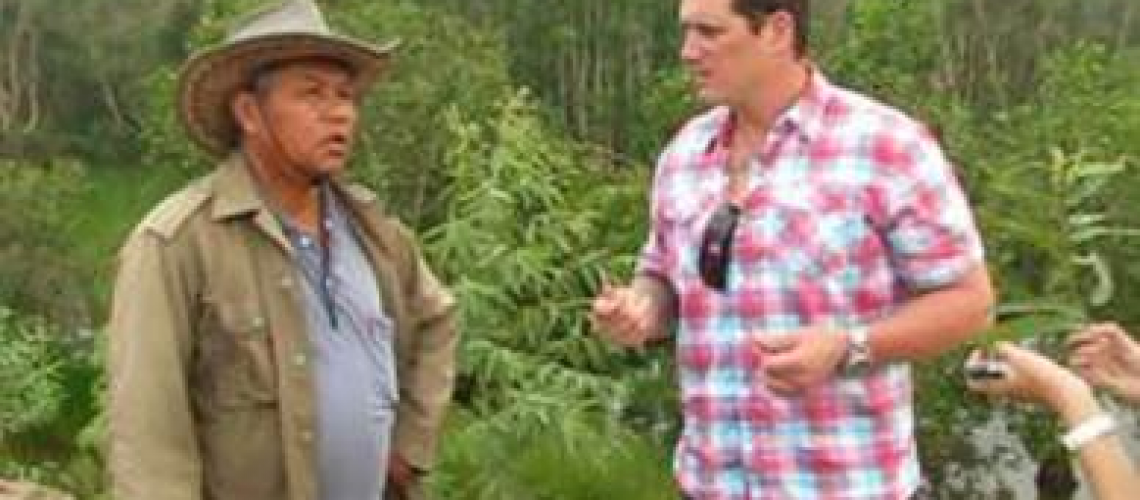
Deep in the Mekong delta Damien meets with Mr Nguyen Van Be or ‘Mr Be’.
In the Mekong Delta I manage to get an appointment with one of the country’s most renowned physicians. Nguyen Van Be, usually referred to as “Ong Ba Dat Phen”, translates as the “Man in the second position of the family in the acid land”.
After studying and eventually lecturing in Western medicine, Be moved to Dong Thap Muoi and set up the 1 000-hectare sustainable nature reserve from where he practises traditional medicine and runs a pharmaceutical company.
For the past 28 years he has transformed the area into a series of jungle canals, nurseries and balanced ecosystems between plants, animals and communities. The many laboratories onsite attract international guests studying traditional Vietnamese and Western medicine. Be claims to be able to accurately use all of the native plants in Vietnamese medicine and is leading efforts to rewrite ancient scriptures. He sleeps only four hours a day and has not personally utilised any form of Western medicine for almost three decades.
He drove us around the reserve explaining the many intricate ecological balances that revolve around each other. He spoke of previous issues similar to Africa’s: poaching, invasive species, fire and community resentment against a protected area – all issues he had eventually overcome.
I became increasingly uneasy as I struggled to think of how I would approach the issue of rhino horn with him. That the rhino horn trade is illegal is commonly known in Vietnam, yet it doesn’t restrict its use and if anything makes it a seemingly more desirable commodity.
Back at the main reception area, I took out my laptop and started the 2010 60 Minutes documentary of our team darting and de-horning rhino in Africa. We reached the point where the chainsaw was tearing through the horn of the great black rhino bull Shungu, and eventually it dropped to the ground. I stood holding the horn in my hand, something so desired in the Far East, something so valuable. We watched the animal receive the antidote, rise, and run off in a cloud of dust. The impact was profound. I had his attention. It was time to talk. We started a conversation that went on for five hours and would leave my interpreter exhausted, asleep at the table.
I explained this Great War raging in Africa. Of conservationists trying to save the rhino from extinction, and poachers from many levels of society risking their lives to get their hands on this prize for sale in the Far East. I told him we were losing this war. I was not in Vietnam to point fingers, rather to understand the history and culture of TVM and the use of rhino horn. Was there a future for it and could education efforts from the West persuade against its use? He came to understand the desperation we were facing and the angle of my approach in Vietnam. Can the market demand be changed? If it can – how? If it can’t – then what?
Although his research and business now focus on the use of plant products, he has an intimate knowledge of rhino horn, its history within Eastern medicine and its healing properties. He spoke of a more than 1 000-year-old history in Vietnam and of its appearance in the ancient scriptures of traditional Chinese medicine.
We spoke of the concept of curing cancer of which he strongly advised that there was no proof, and that it was a myth. It is this myth, he states, that has pushed the value of rhino horn to US$36 000 a kilo among the traditional medicine community in Vietnam and put it out of reach of most practitioners, including himself. When the horn is used in medicinal practices, only tiny amounts of around one gram are used at a time. This would give a 7kg horn 7 000 applications. Or, as it is generally sold in 100g amounts, 100 applications to 70 patients.
I asked Be what he thought were some of the solutions we could offer people in Africa to help them understand that within TVM, rhino horn seemingly works and perhaps we should consider legalising the trade to supply the demand.
“It is a complicated problem at the moment. There needs to be research done on the effects of the horn when used in traditional medicine. There must be co-operation between Asia and Africa in this research,” he said.
He thinks we should be farming the rhino to meet the demand of the Asian market.
Be struggles to understand why this product can be taken without killing the animal, yet animals are being killed for it.
Be went on to say: “Currently it’s only available to the very rich and is sometimes displayed in their homes as a status symbol. The horn is only used as a last resort in traditional medicine. In general it’s not used as a daily treatment.”
He concluded: “If the rhinos are farmed then there need to be specific regulations and rules regarding the treatment of the animals. They should not be harmed in the process of farming or harvesting.”
To me, protection makes sense when one would want to harvest such a valuable commodity every three years. I left on good terms with Be.
By Damien Mander
June 29 2012 at 12:13pm
The Mekong Delta: learning the rhino doesn’t have to be killed

